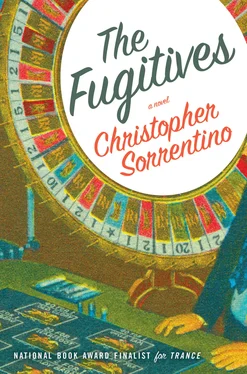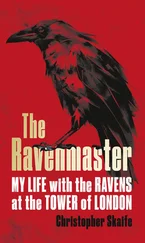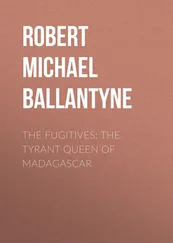It was already wearing me out, in other words, to have this much contact with the world after months in retreat from it. The phone calls from Fecker, Arlecchino, and Harris were quite enough; the burlesque unreality that came out of the tiny, tinny telephone speaker was like a blast from a Kaufman and Hart play. (Anyway, they didn’t really require anything of me in telling their tales of woe; my response wasn’t the point. No story requires an audience, just the willing credulity of the teller. That’s what makes it glow. Possibly that’s the problem with politicians, or with their speeches, anyway: they feel that if they assemble an audience they have only to pour sentiment over it, like oil over a gigantic salad.) But Kat had brought with her the unmistakable feeling of dawning intrigue and strategy, and I had no appetite for it. I couldn’t figure out if that made me sick or well. There I was, supposedly writing a book. Just write it, and Kaufman, Hart, Groucho, Chico, Abbott, and Costello all shut up. It was a simple prescription: avoid intrigue, write. They shut up, I stop hanging around the children’s library, stop with the Omega Man fantasies, and go visit my mother like every other mope does when he journeys home to the midwest from one of the shining, night-bright coasts. They shut up, and Kat goes back to Chicago and solves her marital problems. They shut up, and I go back to New York and live like any other solid citizen, writing gently critical book reviews and chortling with forced laughter at crowded parties thrown in overheated brownstone apartments or galleries with high-res photos of vulvas on the walls. Like every incorrigible nutcase in this sloppy and fucked-up vale of tears and trans fats and thousand-dollar handbags, I wanted to make the voices stop.
I put on my boots and my parka and went for a walk, crossing Division and taking a long, slow swing through the grounds of the lunatic asylum. The broad lawn the facility presented to the street receded toward a planted cedar grove, with paved footpaths leading to the various buildings, actually various complexly arranged wings extending from each other and anchored by the grandest of them, Building 50 so-called, a looming structure topped by multiple red spires. The setting was reminiscent of a small and grimly unphotogenic agricultural college, except that most of the buildings were unoccupied or undergoing major renovation. Signs nailed to the doors announced some of the future uses to which these buildings would be put: a nature center, a children’s museum, headquarters of the local historical society. The smaller buildings were severely functional, with long, narrow windows whose multiple muntins, where they were intact, resembled bars from a distance. Building 50 itself was surrounded by chain-link fencing, behind which various pieces of mid-sized construction equipment were parked, some still covered with snow. A placard had been affixed to the fence that read:
5 °COMMONS
You’re Home
Luxury Residential and Retail Spaces
For Purchase and Lease
There was an architect’s rendering with the usual hopeful tableau — couples holding hands, children carrying balloons and pointing excitedly into the distance, smiling Rollerbladers, a woman loading a flat of flowers into the back of a minivan — that imagined the looming structure with its gaunt and faded spires as a happy castle ballasted with gleaming shops whose windows bore signs like GOURMET SPECIALTIES, BISTRO, FINE WINES. Not too fanciful a projection, given the evidence of Front Street’s relatively recent evolution, but still an upgrade away from the town’s current level of self-conceit. Beneath, a small legend announced that the undertaking was a project of Morello Developers, LLC.
Following the main footpath, which widened as it drew near to the complex, I circled around the buildings. Here and there plywood had been removed from the window openings and you could see the interior, all peeling paint and ravaged, water-stained walls and ceilings. Behind everything was a low post-and-rail fence dividing the main grounds from acres of farmland. The nuthouse had, in keeping with the philosophy of the day, put patients to work tending to crops and livestock. In the summer, tall grass rose now where once had risen rows of corn, and the gnarled unpruned forms of cherry trees leaned into one another in the orchard. Barns and other outbuildings had faded to the same dusty red as the spires atop Building 50. Here and there. Everything here and there in the ghost park, as if it hadn’t yet accommodated itself to its civic repurposing. I always walked it as if the open space to be spanned between each leftover object, each ruin, was a nullity; as if the place’s true life lingered in all the lonely corners they were determined either to polish or destroy. Hard to imagine enjoying a picnic on that broad green presenting its placid face to Division, with the specter of forced confinement literally hanging over your shoulder; harder still to imagine moving into 5 °Commons: showering, cooking, telling bedtime stories, making love in the banshee zone of bitter delusion, sadness, and captivity.
The sign on the fence around Building 50 was new, late-breaking news from the corporate sphere. I don’t know what exactly I had believed before, but the sign informed me now that even here, on my own, “it”—meaning pretty much anything and everything — would find me; that there were no holy places of understatement and untapped utility in American life; that the belief in the beauty of the not-so-nice, in the value of forsaking the dollar that could be rendered from the bones of anything, was a dying one — and that was what the jangling demands of Dylan, of Monte, of Boyd Harris himself had been prompting me to recognize. I’d wanted to climb beyond the plateau of accountability — first the accountability of married life, and then my apparent accountability to those who thought I owed them moral consistency, and finally the accountability that used to measure itself out in pieces of silver. Ultimately that was what I owed; the same thing that was demanded of these acres and the buildings on them, the justification that I wasn’t just taking up space, consuming resources. O, to be twenty-five and back in my Williamsburg sublet, jerking off into a napkin, a paragraph of juvenilia, drawn from the Nothing of ignorance — drawn, actually, from other people’s books — awaiting me in the typewriter (O, gentle machine). Was that where the fascination with Salteau had come from? His purchase on the undemanding legends that conjured a world apart from trade, where things appeared and were given names and permitted to exist in harmony with each other? Yeah, sure. There was no point in fetishizing the primitive: Salteau probably lived in a trailer out by a gravel pit somewhere. I wondered about Kat’s apparent reticence with Salteau. If she would only wrap her story up, we might spend an inconsequential night together. This was how I always should have done things: casual, unserious, not exactly respectable but hardly irresponsible, and what nobody knows doesn’t hurt anybody. Would that I had had the nature, if not the wisdom, to crawl out of Susannah’s bed after getting my taste and return to my wife, my kids, my books, my desk, with a rejuvenated sense of appreciation, rather than taking them all in with the coldly appraising eye of a horse trader.
About 300 degrees into my circuit of the complex I spotted a sandwich board set up outside one of the doors. Engraved in the lintel was DISPENSARY, and, true to the mild irony of the times, the board announced in fluorescent chalk the grand opening of the Dispensary Café. I went inside the empty place and ordered a coffee from the kid behind the counter, midwestern as a scarecrow but scored with dark green Maori designs up and down his arms, and took it to a table. Someone had left behind a copy of the alternative weekly, Northern Exposure, and I flipped through it, locating amid the listings for the bar bands, the historic home tours, the Hemingway trail, and the ads for the Manitou Sands casino, a small boxed ad announcing Charlevoix’s Annual Indoor Smelt Fry on Saturday, which among other things would feature the appearance of “renowned” Native storyteller John Salteau.
Читать дальше












